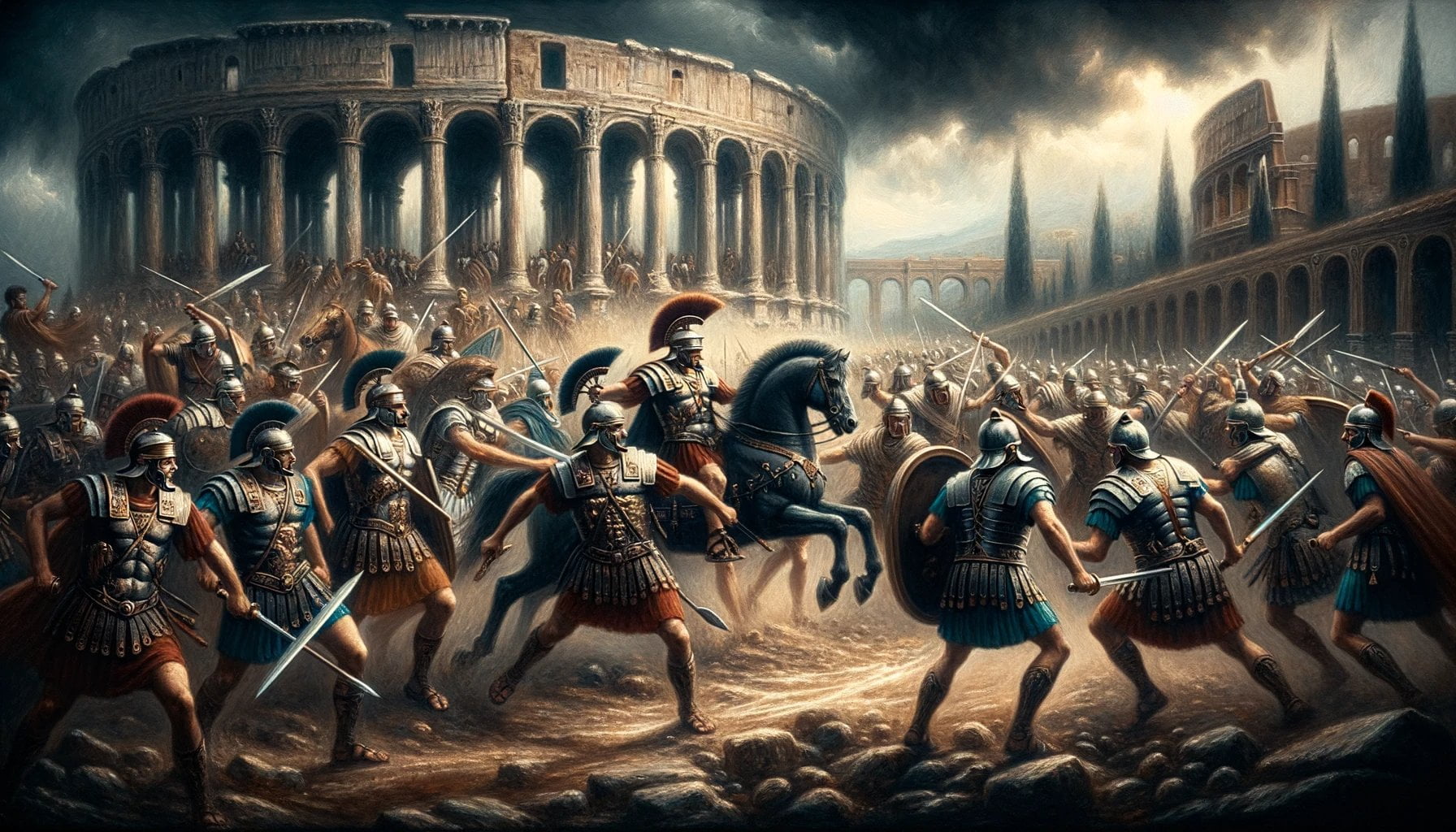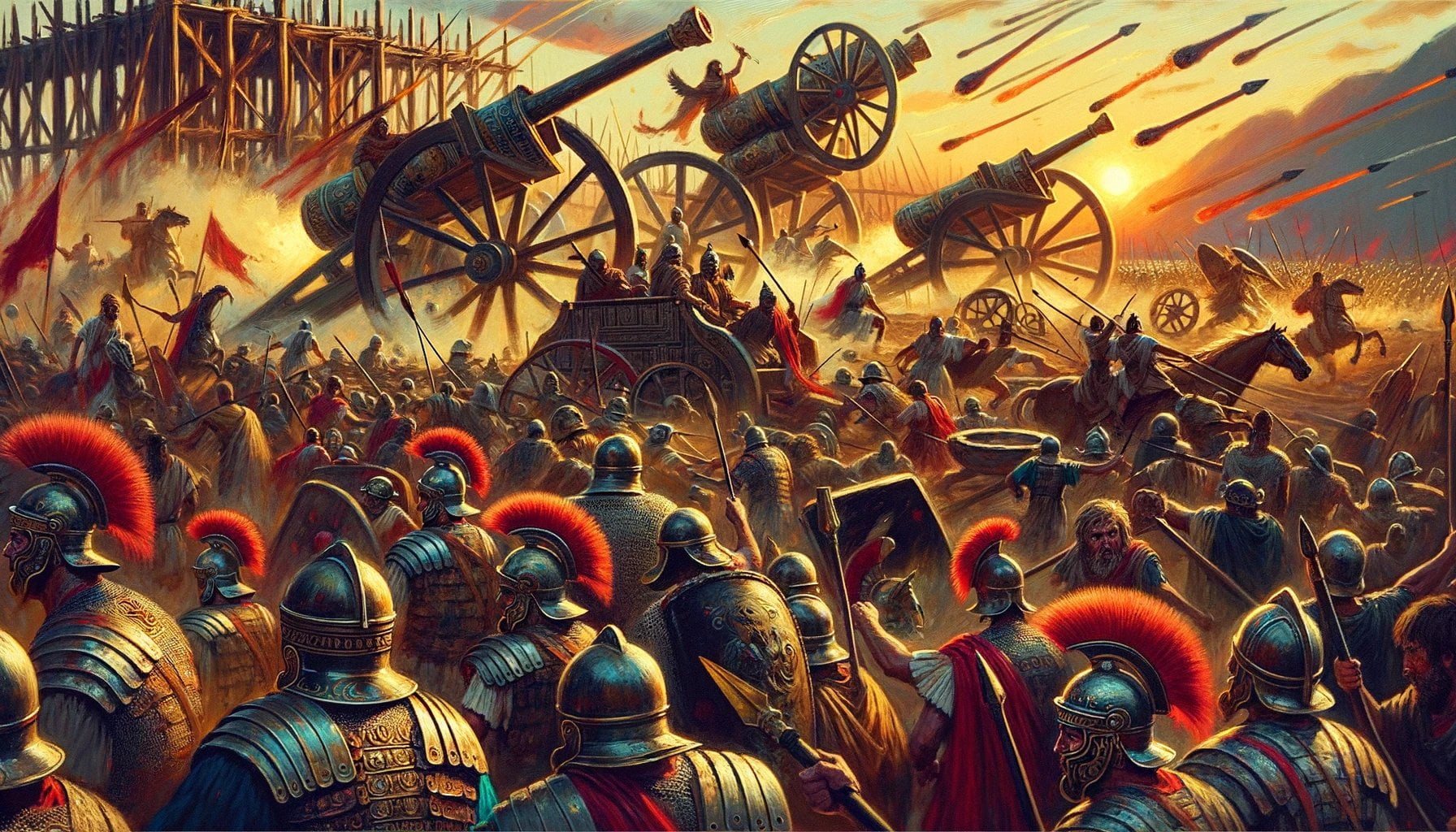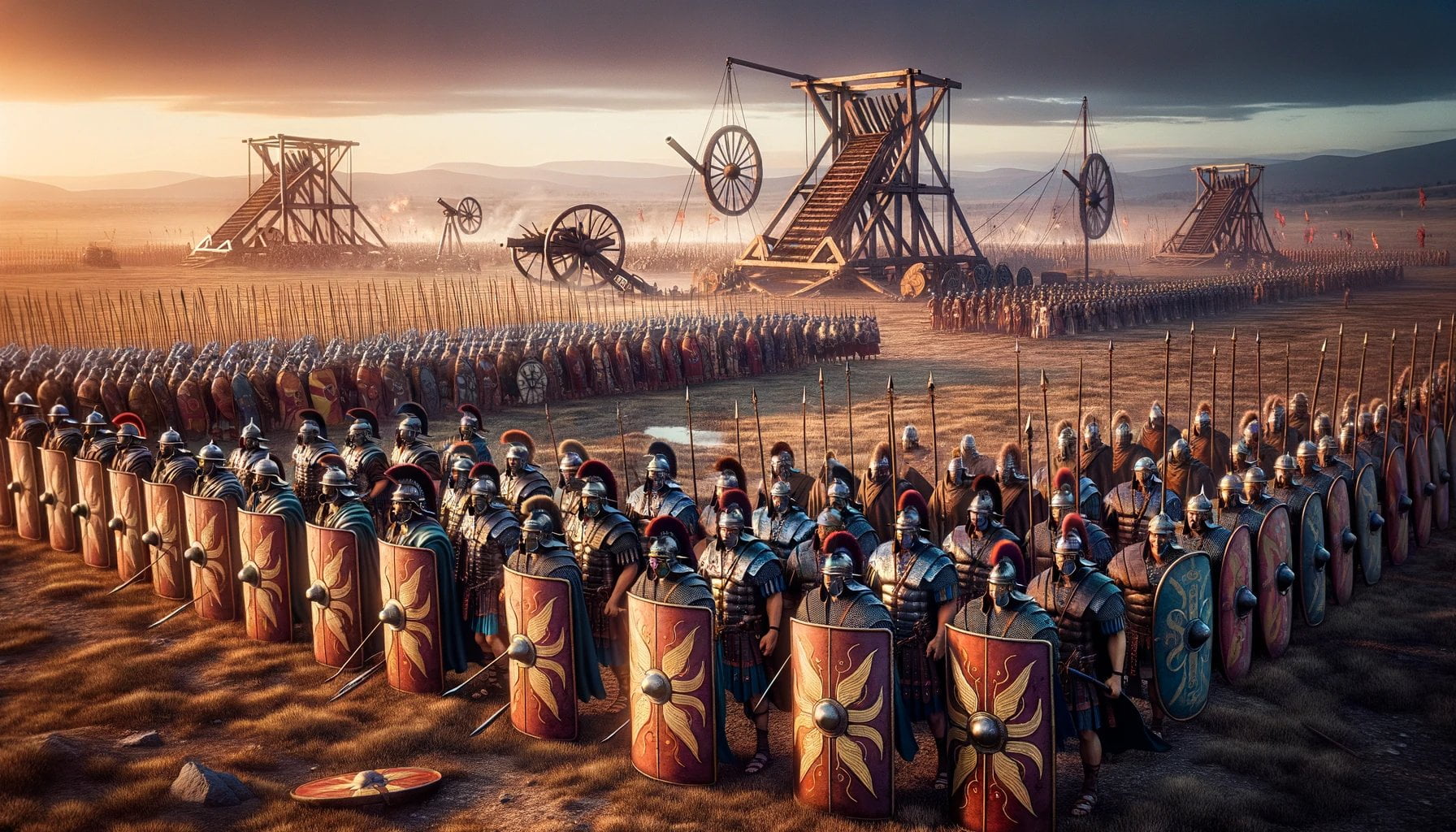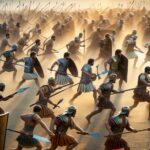Welcome to the captivating realm of ancient battle tactics in Rome. In this article, we will delve into the intriguing world of the Roman Empire, exploring the military strategies employed by Roman legions during ancient battles. Drawing upon extensive historical accounts and archaeological findings, we will uncover the secrets of Roman military infrastructure, formations, and weaponry. Join us as we unveil the captivating and often tumultuous world of ancient warfare in Rome.

Key Takeaways:
1. The ancient Roman Kingdom, Republic, and Empire engaged in numerous external wars and battles.
2. These conflicts spanned from the 8th century BC to the 2nd century BC and were listed chronologically.
3. Notable wars and battles include those fought against the Latins, Sabines, Cameria, Fidenae, Veii, Volsci, Aequi, Etruscans, Gauls, Samnites, Pyrrhus, Carthaginians, Illyrians, Macedonians, Spartans, and Celts.
4. There were also conflicts with the Seleucids, Aetolians, Galatians, Celtiberians, Lusitanians, Numantians, Achaeans, Transalpinians, Cimbrians, and Jugurthines.
5. The article references the video game “Ancient Battle: Rome” on Steam and Google Play as a source of additional information.
6. Ancienthistorylists.com is another source that provides information on Rome’s greatest battles.
Ancient Battle Tactics in Rome
Welcome to the intriguing world of ancient battle tactics in Rome! In this article, we will delve into the fascinating realm of Roman warfare, exploring the strategies employed by the mighty Roman legions in their numerous battles throughout history. From the ancient Roman Kingdom to the Roman Republic and the grand Roman Empire, Rome has witnessed a plethora of wars and battles against external enemies. Let’s embark on a journey through time and uncover the secrets of Rome’s military prowess.
Wars and Battles of Ancient Rome
The annals of Roman history are replete with accounts of epic conflicts and military triumphs. The list of Roman external wars and battles is extensive, spanning from the 8th century BC to the 2nd century BC. These battles were instrumental in shaping the destiny of the Roman Empire and solidifying Rome’s position as a dominant force in the ancient world.
Among the notable conflicts, we have the Wars with the Latins and the Sabines, the Conquest of Cameria, the War with Fidenae and Veii, the First Latin War, the Battle of Aricia, the Wars with the Volsci and the Aequi, the Battle of Veii, the Roman-Etruscan Wars, the Battle of the Allia, the First Samnite War, and the Latin War. These engagements showcased the military might of Rome and established its prowess on the battlefield.
Rome and Its External Foes
Throughout its history, Rome faced numerous external enemies who sought to challenge its dominance. A variety of conflicts ensued, such as the Roman–Seleucid War, the Aetolian War, the Galatian War, the First Celtiberian War, the Third Macedonian War, the Third Illyrian War, the Lusitanian War, the Numantine War or Second Celtiberian War, the Fourth Macedonian War, the Third Punic War, the Achaean War, the First Transalpine War, the Cimbrian War, and the Jugurthine War. Each battle presented unique challenges for the Roman legions, requiring adaptability and strategic thinking.
Unraveling Roman Battle Tactics
To understand the ancient battles of Rome, we must dive into the core of Roman military tactics. The Romans were renowned for their mastery of organized warfare and their ability to form disciplined legions. From the manipular formations of the early Republic to the later cohort-based formations, Roman soldiers fought in tight, well-structured units that maximized their collective strength. The use of standardized equipment, such as the gladius (short sword) and scutum (rectangular shield), further added to their advantage.
The Roman legions incorporated a wide array of battle tactics, including the famous Testudo formation, where soldiers interlocked their shields to form an impenetrable turtle-like shield wall. They also employed strategies like the oblique order, a slanted battle line designed to flank and overwhelm the enemy, as well as the famous double envelopment, encircling the opposing force for optimal tactical advantage.
Analyzing Ancient Battles
To gain insight into these ancient battles, historians and military strategists rely on a range of primary sources, including historical accounts and archaeological findings. By carefully examining these sources, we can reconstruct the events of the past and unravel the strategies employed by Roman legions.
One such significant event is the Battle of Cannae, which took place during the Second Punic War between Rome and Carthage. In this clash, Hannibal, the Carthaginian general, executed a brilliant double envelopment maneuver, annihilating a much larger Roman army. The Battle of Cannae serves as a prime example of the devastating effectiveness of well-executed Roman battle tactics.
The Legacy of Ancient Rome
The battles fought by ancient Rome have left an indelible mark on history. Roman military tactics and strategies continue to be studied and emulated even today. The legacy of Rome’s military prowess extends far beyond its borders, influencing countless later civilizations and military minds.
So, whether you’re a history enthusiast, a military strategist, or simply intrigued by the ancient world, the captivating realm of ancient battle tactics in Rome offers a rich tapestry of knowledge and exploration. Discover the triumphs, the strategies, and the timeless allure of Rome’s military legacy. Join us as we uncover the intriguing world of ancient battle tactics in Rome.
Note: If Alexa is using the output as part of a blog post, she may edit out any direct instructions to herself (i.e. “Please avoid using the title…”) and may rephrase or reformat the content for a better flow.
In ancient Rome, poetry was an art form that captured the essence of the civilization. Explore the rich world of poetry in ancient Rome by clicking here.
Discover the hidden gems of ancient Rome’s villages and the unique way of life they offered. Immerse yourself in the world of villages in ancient Rome by clicking here.
Experience the thrill and excitement of games in ancient Rome, where entertainment and competition were taken to a whole new level. Get a taste of ancient Rome’s games by clicking here.
Uncover the stories of the invaders who impacted ancient Rome’s history and shaped its destiny. Dive into the intriguing world of invaders of ancient Rome by clicking here.
Learn about the influential role of praetors in ancient Rome, the highest judicial and executive officers. Discover the power and responsibilities of praetors in ancient Rome by clicking here.
Experience the graceful movements and cultural significance of dance in ancient Rome. Feel the rhythm of ancient Rome’s dance by clicking here.
Key Figures and Leaders in the Battle
Key Takeaways:
– In the battles of ancient Rome, several influential figures and leaders emerged, shaping the outcomes and legacies of these conflicts.
– Julius Caesar stood out as one of the most prominent leaders, playing a vital role in the Roman-Latin War from 49 BC to 45 BC. His reforms and military prowess made him a superhero in the eyes of the Roman people.
– King Pyrrhus of Epirus showcased his strategic brilliance in the Pyrrhic War, fought against the Roman Republic from 280 BC to 275 BC. Despite winning battles, his victories came at great cost, earning the term “Pyrrhic victory.”
– Hannibal, a Carthaginian general, led the Carthaginian forces in the famous Battle of Cannae in 216 BC. His tactical genius and implementation of the double envelopment strategy caused a devastating defeat for the Roman army.
– Octavian, later known as Emperor Augustus, played a decisive role in the Battle of Actium in 31 BC. His victory over Mark Antony and Cleopatra resulted in the establishment of the Roman Empire.
– Scipio Africanus, a Roman general, played a pivotal role in the Second Punic War. He defeated Hannibal in the Battle of Zama in 202 BC, securing Rome’s victory and ending the war.
– Other key figures include Pyrrhus, King of Epirus; Carthaginian general Hannibal Barca; and Mark Antony, who aligned with Cleopatra in the Battle of Actium.
The ancient battles of Rome were not only determined by the military strategies employed but also by the visionary leaders who commanded their troops. Understanding the key figures and leaders in these battles sheds light on their impact on Rome’s history and legacy.
Sources:
- Ancient History Lists. “Top 12 of Rome’s Greatest Battles.” Link
- History Hit. Ricketts, Colin. “10 of Rome’s Greatest Battles.” Link
Unveiling the Intriguing World of Ancient Battle Tactics in Rome
The ancient Romans were known for their strategic and effective battle tactics, which played a crucial role in their military victories and the expansion of the Roman Empire. Let’s delve into the events and tactics of these ancient battles and explore the innovative strategies employed by Roman legions.
The Triple Line Formation: Maniple Innovation
One of the most notable battle formations used by the Romans was the Triple Line, also known as the Maniple formation. This formation consisted of three distinct ranks and was considered highly innovative for its time. Soldiers in the front rank would engage the enemy, while the soldiers in the rear ranks provided support and reinforcement[^1][^2].
The Power of the Wedge: Penetrating Enemy Lines
Another significant tactic employed by the Romans was the Wedge formation, also known as the flying wedge or flying V. This formation involved a concentrated group of soldiers forming a triangular shape, allowing them to penetrate enemy lines with great force[^1].
The Defensive Testudo Formation: A Shielded Shell
The Testudo formation, meaning “tortoise” in Latin, was a defensive formation used by the Romans. In this formation, soldiers formed a shield wall for protection, creating a shell-like structure. The Testudo formation was particularly effective against missile attacks and provided excellent defense for soldiers[^1][^2].
The Deadly Plumbata: Precision Throwing Dart
The Romans utilized a variety of weapons alongside their creative battle formations, such as the Plumbata. This weapon was a weighted throwing dart with feathers, similar to a modern-day arrow. The Plumbata was known for its accuracy and ability to target enemies from a distance[^1].
Onagers: Ancient Roman War Machines
The Romans were no strangers to innovative war machines, and one of the most notable was the Onager. This ancient artillery launched large stones and arrows towards the enemy with great force. The Onager was particularly effective against close-order formations and structures[^1].
Greek Fire: Chaos in Naval Battles
In their quest for military superiority, the Romans developed Greek Fire, a highly flammable liquid. This tactical weapon could be projected onto enemy ships, causing extensive damage and creating chaos in naval battles[^1].
The Corvus: Roman Naval Boarding Device
During naval battles, the Romans utilized the Corvus, a boarding device that allowed soldiers to board enemy ships. This ingenious invention effectively turned naval battles into infantry combat, giving the Romans a significant advantage[^2].
The Pilum: Piercing Enemy Shields
Another noteworthy weapon used by Roman soldiers was the Pilum, a javelin-like projectile. The design of the Pilum allowed it to pierce through enemy shields, causing confusion and disruption in their formations. This versatile weapon could be thrown or used in close combat[^2].
The Carroballista: Long-Range Missile Attacks
For long-range missile attacks, the Romans employed the Carroballista, a siege weapon similar to a large crossbow. This powerful weapon launched projectiles with great accuracy and force, allowing the Romans to weaken enemy defenses during sieges[^1].
The Importance of Medical Treatment: Swift Recovery
In addition to their innovative formations and tactics, the ancient Romans placed great emphasis on medical treatment on the battlefield. Skilled medics and surgeons provided immediate care to wounded soldiers, increasing their chances of survival and allowing them to return to battle more quickly[^1].
Key Takeaways:
- The Romans employed innovative battle formations and tactics, including the Triple Line, Wedge, and Testudo formations.
- They made effective use of weapons such as the Plumbata, Onager, and Carroballista.
- Greek Fire and the Corvus played key roles in naval warfare.
- Roman soldiers utilized the deadly Pilum weapon for close combat.
- Medical treatment on the battlefield was prioritized, ensuring swift recovery for wounded soldiers.
Sources:
- HistoryTen: Top 10 Ancient Roman Battle Tactics
- Ancient History Lists: Top 12 Important Roman Military Tactics
Outcome and Significance of the Battle
The Battle of the Milvian Bridge, fought on October 28, 312 CE, marked a major turning point in Roman history. This battle was a crucial event in a civil war between Constantine I and Maxentius, two contenders for the imperial throne of the Roman Empire. The outcome of the battle had significant implications for the future of both the empire and Christianity.
The Battle and Its Events
Before delving into the outcome and significance of the battle, let’s briefly explore the events leading up to it. Following the collapse of the Roman Empire’s Second Tetrarchy, Constantine and Maxentius emerged as rivals, each vying for sole control of the Western Roman Empire.
Maxentius, in an attempt to provoke Constantine, initiated the conflict by invading Rome. Constantine, with his strategic military prowess, decided to confront Maxentius in battle rather than wait for an attack on his forces.
It is said that before the battle, Constantine had a fateful encounter with a Christian omen, which may have influenced his decision to convert to Christianity. This newfound faith would later shape the political and religious landscape of the Roman Empire.
On the day of the battle, Constantine’s army engaged in fierce combat against Maxentius’s forces near the Milvian Bridge. While the exact casualties remain unknown, historical accounts indicate that Maxentius’s army was ultimately defeated and suffered significant losses, including Maxentius himself, who died during retreat.
The Outcome
The outcome of the Battle of the Milvian Bridge proved to be momentous. With the defeat of Maxentius, Constantine emerged as the sole ruler of the Western Roman Empire. This victory solidified his position as the dominant figure in the empire and set the stage for his subsequent actions.
The Significance
The Battle of the Milvian Bridge holds immense historical significance due to its impact on the Roman Empire and the establishment of Christianity as the state religion.
Roman Empire: Consolidation of Power
Following his victory, Constantine’s rule was solidified, and he embarked on a path of reunification and consolidation of power within the Roman Empire. He implemented administrative reforms and took measures to stabilize the empire, setting it on a course towards stability and prosperity.
Religious Transformation: The Rise of Christianity
Perhaps the most profound consequence of the battle was Constantine’s decision to convert to Christianity, ultimately leading to the establishment of Christianity as the state religion of the Roman Empire. This dramatic religious transformation had far-reaching effects on the empire’s culture, religious practices, and societal norms. It marked a significant turning point in the history of Christianity, as the faith began to flourish and gain prominence within the Roman Empire.
Key Takeaways:
- The Battle of the Milvian Bridge took place in 312 CE and was a major conflict in a Roman civil war between Constantine I and Maxentius.
- Constantine’s victory in the battle solidified his position as the sole ruler of the Western Roman Empire.
- The battle had significant implications for the Roman Empire, including the consolidation of power under Constantine’s rule.
- One of the most significant outcomes of the battle was Constantine’s conversion to Christianity, leading to the establishment of Christianity as the state religion of the Roman Empire.
- This battle marked a turning point in Roman history and had a lasting impact on the empire’s political and religious landscape.
Sources:
– Battle of the Milvian Bridge | Summary, Outcome – Britannica
– Battles of the Roman Empire – World History Encyclopedia

FAQ
Q1: What were some of the greatest battles fought by the Romans?
A1: Some of the greatest battles fought by the Romans include the Roman-Latin War, the Macedonian War, the Pyrrhic War, the Gallic War, the Battle of Silva Arsia, the Battle of Heraclea, the Battle of Agrigentum, the Battle of Cannae, the Battle of Carthage, the Battle of Zama, the Battle of Immae, and the Battle of Actium.
Q2: What were some of the battle formations used by the Romans?
A2: The Romans used various battle formations, including the Triple Line formation or Maniple, the Wedge formation, the Testudo formation, and the Flying V formation. They also utilized tactics like the Plumbata, the Onager, Greek Fire, the Corvus, the Pilum, the Carroballista, and medical treatment on the battlefield.
Q3: What was the significance of the Battle of the Milvian Bridge?
A3: The Battle of the Milvian Bridge was a major battle in a Roman civil war between Constantine I and Maxentius. Constantine’s victory led to his establishment as the sole ruler of the Western Roman Empire and played a crucial role in the establishment of Christianity as the state religion.
Q4: What impact did the Battle of the Milvian Bridge have on the Roman Empire?
A4: The Battle of the Milvian Bridge marked a turning point in Roman history. Constantine’s victory resulted in his ascendancy as the sole ruler of the Western Roman Empire and had a lasting impact on the empire’s political and religious landscape, leading to the establishment of Christianity as the state religion.
Q5: How did the ancient Romans provide medical treatment on the battlefield?
A5: The ancient Romans placed great emphasis on medical treatment on the battlefield. They had skilled medics and surgeons who provided immediate care to wounded soldiers, increasing their chances of survival and allowing them to return to battle more quickly. This attention to medical treatment contributed to the Roman military’s effectiveness and success.
- Unveiling the Enigma: Mansoureh Khojasteh Bagherzadeh’s Public Appearances & Private Life in Iran - July 18, 2025
- Unveiling the Mystery: Mansoureh Khojasteh Bagherzadeh’s Husband: A Rare Glimpse into a Private Life - July 18, 2025
- Unveiling Masoud Khamenei’s Mother: Power, Influence, and Iran’s Future - July 18, 2025
















